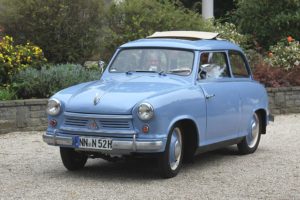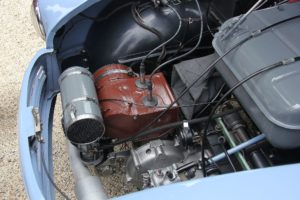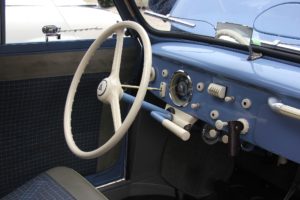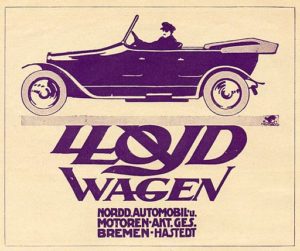Originally published in April 2016 | Updated October 2024
The Lloyd Wagen is a delightful surprise in automotive history. While it emerged from one of Germany’s prestigious automakers, this charming Lloyd Motoren Werke G.m.b.H. mini car proved to be far more than just a compact vehicle. Every detail, from its innovative engineering to its thoughtful design, makes the Lloyd a testament to German craftsmanship – proving that excellence comes in all sizes
The Unique Lloyd Wagen

1955 Lloyd image by Lothar Spurzem (Own work) [CC BY-SA 2.0 de, via Wikimedia Commons[/caption]
A History of the Lloyd Automobile
The Lloyd Legacy: From Electric Beginnings to Post-War Innovation
Early Origins (1906-1914)
While many admirers might recognize the charming 1955 Lloyd model, the story of this remarkable automobile began much earlier. In 1906, the Norddentsche Automobilund Moteren A-G company launched their first Lloyd motor wagen, setting the stage for decades of innovation.
The company’s early vision was particularly forward-thinking – they started by production of cars – licensed electric vehicles based on Kriéger designs. Belgian electrical engineer Paul Mossay played a pivotal role during these formative years, spending four years as chief engineer developing both electric and petrol-powered vehicles.
The Hansa-Lloyd Era (1914-1929)
A significant turning point came in 1914 when Lloyd merged with Hansa to create the Hansa-Lloyd brand known as Hansa-Lloyd Werke AG. While the company faced its share of financial challenges during this period, it continued to innovate. The Hansa-Lloyd name became synonymous with robust commercial vehicles, while passenger cars typically carried the Hansa badge.
Military Ventures and Challenges
In 1917, Hansa-Lloyd ventured into military vehicle production, though not without some memorable mishaps. During testing of their first armored vehicle, engineers discovered its forward-heavy design could lead to some rather dramatic moments – including one memorable summer incident where a test vehicle actually tipped over! While the company’s military vehicles showed promise, they were eventually overshadowed by more advanced designs like the Sturmpanzerwagen A7V.
The Borgward Chapter and Wartime Years
In 1929, the company entered a new phase when Carl F. W. Borgward acquired Hansa. Until 1937, Hansa-Lloyd’s reputation for excellent commercial vehicles continued, with models ranging from the nimble one-ton Express to the mighty five-ton Merkur truck. World War II brought dramatic changes, as the factory shifted to armaments production before being ultimately destroyed in Allied bombing raids.
Post-War Renaissance: The People’s Car
The 1950s marked a remarkable comeback for the German automobile manufacturer, Lloyd. Now operating as Lloyd Motoren Werke GmbH in Bremen, the company found its true calling – creating affordable, reliable cars like the Borgward Arabella for post-war Germany. Their success was remarkable, with sales figures trailing only Volkswagen and Opel.
The Charming Lloyd Models
The Lloyd 250: The “Exam Anxiety” Car
One of the most endearing models was the Lloyd 250, affectionately nicknamed the “Prüfungsangst-Lloyd” (exam anxiety Lloyd). This clever little car became popular among older drivers who preferred to avoid the more stringent driving tests required for larger vehicles. While it came stripped-down – no rear seat, bumpers, or hub caps – many proud owners happily added these features later.
The Lloyd 300: The “Sticking Plaster Bomber”
Perhaps the most characterful model was the Lloyd 300, with its unique wood framing and original fabric body construction. It earned the affectionate nickname “Leukoplastbomber” because owners would patch small tears in the fabric body with Leukoplast (sticking plaster). This led to the humorous saying, “Wer den Tod nicht scheut, fährt Lloyd” (He who isn’t afraid of death, drives a Lloyd!) – a testament to both the car’s distinctive character and its owners’ devotion.
The Lloyd 600 and Lloyd Alexander: Engineering Evolution
The later Lloyd 600 and Alexander models showcased the company’s growing sophistication. These models featured innovative air-cooled, two-cylinder engines with chain-driven camshafts. The Alexander added practical touches like a rear luggage hatch, while the Lloyd 600 demonstrated clever space utilization with its compact 25-litre fuel tank design.
The Australian Chapter: Lloyd Goes Down Under
The Lloyd-Hartnett Partnership
In the late 1950s, a fascinating automotive partnership brought German engineering to Australian shores. Carl Borgward and Laurence Hartnett joined forces to introduce the Lloyd 600 to the Australian market, branding it as the Lloyd-Hartnett. From its debut in December 1957 until the production line’s closure in 1962, this unique venture produced 3,000 vehicles, each representing a perfect blend of German design and Australian assembly.
A Model for Every Need
One of the most charming aspects of the Lloyd 600 was its versatile lineup, distinguished by a clever naming system that told you exactly what you were getting:
- The LP 600: A classic sedan (or “Limousine” in German)
- The LC 600: A breezy cabriolet for those sunny Australian days
- The LS 600: A practical station wagon for the family
- The LK 600: A sturdy panel van for business needs
Here’s an interesting bit of automotive wordplay: while “LP” officially stood for “Lloyd-Personenwagen” (Lloyd Passenger Car), it playfully became known as the “Leukoplastbomber” – a nickname carried over from its predecessor, the LP300, famous for its unique body construction of synthetic leather over a wooden frame.
Engineering Excellence in Detail
The Lloyd 600’s engineering was a testament to thoughtful design. Let’s look under the hood at what made this car special:
Sophisticated Suspension
The front wheels featured an innovative design with transversely mounted overlapping leaf springs and a three-speed manual gear box, complemented by telescopic shock absorbers for a smoother ride. At the rear wheels, a clever swing axle system worked in harmony with longitudinal leaf springs, delivering both stability and handling finesse.
Safety First
The braking system showed careful attention to safety and reliability:
- All four wheels featured hydraulically-operated drum brakes.
- A separate hand-brake system operated on the front wheels via cable linkage.
- The steering system was precise and user-friendly, requiring just 2¼ turns lock-to-lock.
- With a turning circle of 10.45 meters (34.3 feet), the Lloyd 600 proved surprisingly nimble in city traffic.
The Lloyd Alexander: Evolution of Excellence
The Sophisticated Sibling
While sharing its DNA with the beloved Lloyd 600, the Alexander wasn’t just another pretty face in the Lloyd lineup. This sophisticated model represented Lloyd’s vision of the perfect compact car, offering versatility without compromising on style or function.
Versatility in Design
The Lloyd Alexander was quite the shape-shifter, available in several configurations to suit any lifestyle:
- A sleek two-door saloon for the sophisticated urbanite
- A breezy convertible for sun-seeking enthusiasts
- A practical station wagon for families on the go
- A capable panel van for business needs
All these variations shared Lloyd Alexander’s innovative FF (Front-engine, Front-wheel-drive) layout – a modern approach that enhanced both handling and interior space.
By the Numbers
The Lloyd Alexander’s compact dimensions packed a lot of cleverness into a neat package:
- Length: 3,355 mm (132.1 in) – perfect for city parking
- Width: 1,410 mm (55.5 in) – slim enough for narrow streets
- Height: 1,400 mm (55.1 in) – just right for easy entry
- Weight: A lightweight champion at 540-580 kg empty, capable of carrying nearly its own weight again when loaded (850-910 kg)
The Alexander Advantage
What set the Lloyd Alexander apart from its 600 sibling? Two key innovations made this model special:
Smarter Shifting
While the Lloyd 600 was content with its three-speed transmission, the Lloyd Alexander stepped up the game with a more sophisticated four-speed gearbox and optimized final drive ratio. This combination delivered a more engaging driving experience and better efficiency – a win-win for drivers looking for that extra bit of performance.
Practical Innovation
Perhaps the Lloyd Alexander’s most appreciated feature was its thoughtfully designed rear luggage hatch. No more awkward stretching across the back seat to retrieve your belongings (as Lloyd 600 owners had to do) – just open the Lloyd Alexander hatch and there’s your luggage, ready and waiting. It’s these practical touches that showed Lloyd’s commitment to continuous improvement.
The Lloyd Alexander TS: Performance Meets Innovation
A Sportier Spirit (1958-1961)
The Alexander TS wasn’t just another variant – the Lloyd Alexander TS was Lloyd’s answer to drivers craving more excitement from their compact car. With its enhanced performance and distinctive styling, the Lloyd Alexander TS (Touring Sport) represented Lloyd’s venture into the sporty compact segment.
Power and Performance
The Lloyd Alexander TS brought some impressive upgrades to the table:
- Enhanced engine output: 25 PS (up from the standard 19 PS)
- Larger carburetor for better fuel delivery
- Higher compression ratio of 7.2:1
- Impressive top speed: 107 km/h (68 mph)
- 0-100 km/h sprint in 56 seconds – sporty for its time!
Style and Sophistication
You could spot a Lloyd Alexander TS at first glance thanks to its distinctive “semi-elliptical” front grille with elegant rounded edges. But the real magic lay in its technical innovations:
- All-synchromesh four-speed gearbox for smoother shifts
- Revolutionary semi-trailing arm rear suspension
- Progressive coil springs for enhanced ride comfort
- Advanced features like windscreen washers and asymmetric headlight beams – cutting-edge for 1957!
The Lloyd LP 900 Arabella: A Bold Final Chapter
The Last Lloyd Legend (1959-1963)
The Lloyd Arabella represented Lloyd’s ambitious swan song – a larger, more sophisticated model that showcased everything the company had learned about building fine automobiles. This elegant newcomer featured:
- A sophisticated 897cc water-cooled ‘boxer’ engine
- Impressive 38bhp power output
- Modern all-steel body construction
- Advanced safety features ahead of their time
A Challenging Finale
Despite its technical sophistication, the Borgward Arabella faced tough market conditions:
- Premium pricing positioned it significantly above the VW Beetle
- Production continued with Borgward-branded vehicles after Lloyd’s 1961 bankruptcy
- Total production reached 47,000 units before the final closure in 1963
The Lloyd Arabella stands as a testament to Lloyd’s innovative spirit – even if market conditions ultimately proved challenging, the car demonstrated the company’s commitment to pushing boundaries right until the end.
The Heart of the Lloyd: Engineering & Interior Design
Engineering Excellence: The Lloyd Engine Works Story – From Simple Beginnings to Sophisticated Power
Post-war Lloyd Motor Works engines tell a fascinating story of automotive evolution. While early models featured simple two-stroke engines (typical for their era), the later 600cc powerplant showcased Lloyd’s growing engineering sophistication.

By Lothar Spurzem (Own work) [CC BY-SA 2.0 de, via Wikimedia Commons[/caption]
Technical Mastery in Miniature
The Lloyd’s 596cc engine capacity was a marvel of compact design:
- Parallel twin layout with four-stroke operation
- Innovative radial fan cooling system
- Impressive 19 PS (14 kW) output at 4,500 rpm
- 6.6:1 compression ratio for reliable performance
- Top speed: 100 km/h (63 mph)
- 0-100 km/h in just 60 seconds
Clever Engineering Solutions
Space efficiency was a hallmark of Lloyd design:
- Engine occupied less than 25% of the car’s length
- Compact ‘H-pattern’ column-mounted gearshift
- Economical fuel consumption that beat the VW Beetle
- Ingenious packaging of the 25-liter fuel tank, engine, and six-volt battery under the hood
The Lloyd Interior: Where Form Meets Function

By Lothar Spurzem (Own work) [CC BY-SA 2.0 de, via Wikimedia Commons
Elegant Simplicity
The Lloyd’s interior embodied the best of minimalist design:
- Clean, uncluttered dashboard layout
- Single, clear gauge behind the steering wheel
- Essential controls thoughtfully placed for easy access
Comfort and Practicality
Despite its compact exterior, the Lloyd offered surprising interior comfort:
- Supportive front bucket seats
- Generous rear bench seat
- Clever use of available space
- 1959 Lloyd-Hartnett 600 TS introduced stylish pleated door pockets
The Driver’s Experience
One early driver put it perfectly: the Lloyd handled with the agility of a motorcycle, darting through traffic with surprising nimbleness. This combination of compact size and responsive handling made it ideal for urban driving.

By Alden Jewell (Flickr: 1913 Lloyd Tourer) [CC BY 2.0, via Wikimedia Commons
The Lloyd Legacy: A Microcar with Macro Appeal
More Than Just a Small Car
In the world of collectible automobiles, microcars hold a special place – and few capture hearts quite like the Lloyd. While technically classified as a microcar (under 600cc or less than 10 feet long), the Lloyd stands apart as what you might call a “grown-up” among its diminutive peers.
From Post-War Necessity to Modern Classic
Born from the necessity of post-war Europe, these compact cars tell a powerful story of resilience and innovation. Today, they’re not just collector’s items; they’re rolling history lessons that often steal the spotlight from their more exotic cousins. As one owner noted, a Lloyd turns more heads than any Ferrari or Porsche in their collection!
The “What Is It?” Factor
Every Lloyd outing becomes a conversation starter. Despite once being West Germany’s third most popular car brand (behind only VW and Opel), Lloyd remains a delightful mystery to most onlookers. Of the 355,806 post-war Lloyds produced, only a precious few have survived to tell their tale – making each surviving example all the more special.
Practical Classic
Unlike its microcar contemporaries (the Messerschmitt, Isetta, or Goggomobil with their tiny 200-300cc engines), the Lloyd’s robust 19hp engine makes it surprisingly capable in modern traffic. Yes, even on freeways!
Clever Design Evolution
- Early models earned the nickname “Leukoplastbomber” (“Band Aid Bomber”) for their unique plywood-and-vinyl construction
- By 1957, modern all-steel bodies showed Lloyd’s evolution
- Classic suicide doors add period charm
- Excellent visibility from every angle
- Original keys still work on doors and tailgate – a testament to quality
Standing Apart
The Lloyd chose its own path in many ways:
- 15-inch wheels instead of the typical microcar 10-12 inch size
- Period-correct NANKING 145-R15 tires
- Distinctive baby moon caps with Lloyd’s triangular logo
- Rare ventilated trim rings for extra flair
Surprisingly Spacious
Long before the revolutionary Mini, Lloyd had mastered the art of space efficiency:
- Comfortable seating for four adults
- Adjustable driver’s bucket seat accommodates drivers of all sizes
- Thoughtful interior packaging that belies its exterior dimensions
The Lloyd Legacy: A Lasting Impact
More Than Just a Microcar
The Lloyd isn’t merely a footnote in automotive history – it represents a fascinating chapter of post-war innovation and practical engineering. From its early days as the “Band Aid Bomber” to its evolution into the sophisticated Lloyd Alexander, Lloyd Alexander TS and ambitious Lloyd Arabella, each model tells a story of continuous improvement and thoughtful design.
Engineering Excellence in Every Detail
Throughout its journey, Lloyd consistently demonstrated that size need not limit sophistication. Whether it was the clever packaging of the 600’s engine compartment, the Alexander’s practical rear hatch, or the Arabella’s advanced boxer engine, each innovation showed Lloyd’s commitment to pushing boundaries while maintaining practicality.
A People’s Car with Personality
What sets the Lloyd apart in the pantheon of post-war German automobiles is its unique combination of:
- Practical innovation that enhanced daily usability
- Thoughtful design that maximized interior space
- Engineering that balanced efficiency with performance
- Build quality that has allowed many examples to survive decades
- Character that continues to charm enthusiasts today
The Lloyd’s Enduring Appeal
Today, surviving Lloyds serve as more than just collector’s items – they’re rolling ambassadors of an era when clever engineering and practical design could create something truly special. While the company’s production run may have been relatively brief, its impact on automotive design and its contribution to post-war mobility left a lasting legacy.
Whether drawing admiring glances at car shows or proving its practical worth on modern roads, the Lloyd continues to demonstrate that true innovation knows no size limits. It stands as a testament to the idea that with enough ingenuity and attention to detail, a small car can deliver a truly big experience.
From its factory in Bremen to roads across the globe, the Lloyd story reminds us that sometimes the most remarkable achievements come in surprisingly compact packages. In the end, the Lloyd wasn’t just a car – it was a vision of what thoughtful automotive design could achieve, a vision that continues to inspire and delight automotive enthusiasts to this day.
By: Laure Justice
Join Our Classic Car Community
Keep the Conversation Rolling
Did you enjoy this deep dive into the Lloyd’s fascinating history? This is just one of the many stories we love sharing about classic automobiles. Every vintage car has a unique tale to tell, and we’re passionate about preserving and sharing these automotive legacies.
Connect With Fellow Enthusiasts
Join our growing community of classic car enthusiasts on our Facebook page, where you’ll find:
- More in-depth features on rare and interesting classics
- Engaging discussions with fellow collectors and admirers
- Regular updates on automotive heritage and restoration tips
- A place to share your own classic car stories and photos
Partner With Us
Are you as passionate about classic cars as our readers are? Our dedicated community of automotive enthusiasts represents a highly engaged audience that:
- Actively restores and maintains classic vehicles
- Regularly purchases parts and memorabilia
- Attends shows and events
- Values quality and authenticity
We welcome partnerships with businesses that share our commitment to preserving automotive history. Whether you’re in restoration, parts, memorabilia, or classic car services, let’s explore how we can work together to reach this dedicated audience.
Visit our Facebook page to join the conversation or use the contact form to chat with us about partnership opportunities.
